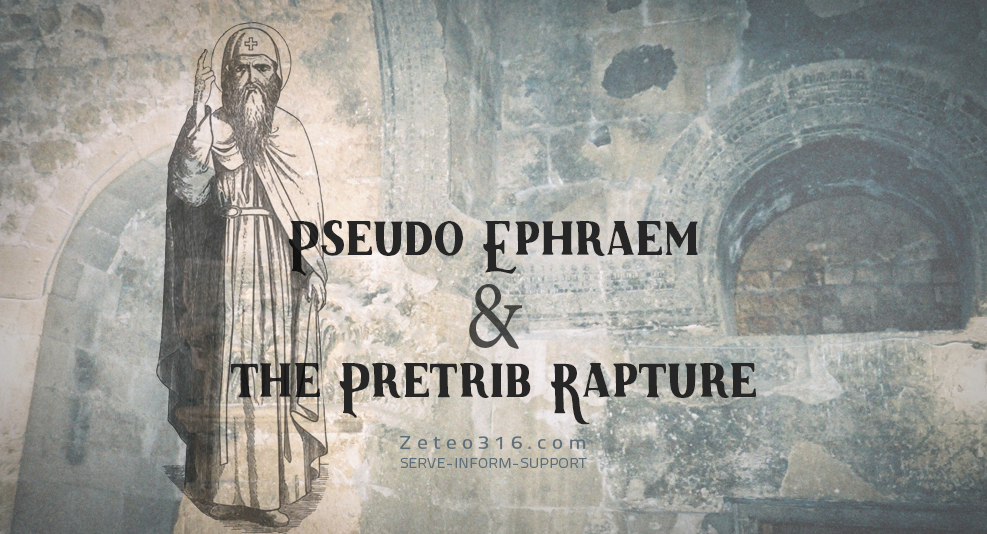
Pseudo Ephraem and the Pretrib Rapture. To P.E. or not to P.E., that is the question!
Years ago Grant Jeffrey excitedly announced that he’d found a pre-Darby pretribulational statement in Pseudo Ephraem (P.E.). My eschatological life began as a posttribber. In some ways I’m still wired to be skeptical about allegedly iron-clad pretrib claims. So I didn’t share Jeffrey’s enthusiasm at the time, even though I’d converted to the pretrib dark side.
This is what caused the fuss:
Woe to those who desire to see the day of the Lord!” For all the saints and elect of God are gathered, prior to the tribulation that is to come, and are taken to the Lord lest they see the confusion that is to overwhelm the world because of our sins…. ~ Pseudo-Ephraem
One odd historical statement shouldn’t trump Scripture, of course. But what amused me were some of the reactions. Google Pseudo Ephraem and click on images to get some idea.
The non-pretrib consensus is that Darby was both the recalcitrant father of dispensationalism and pretribulationism – unless, of course, one can pin it on Edward Irving, the Jesuits…whatever. Hence, finding an earlier document which might support either disp or pretrib would lend some credence to Darby. And we simply can’t have that.
Bob Gundry mulled over it for a while and eventually rejected P.E. as an early pretrib document. You can also read a prewrath response to P.E. from Dr. Charles Cooper HERE.
Criticisms ranged from what P.E. meant by the gathering (symbolic language?), to whether he could be trusted (who was he really?) and to what he meant by the term tribulation. Critics also note what he wrote later in the document regarding resurrections, presumably after this gathering before the tribulation. Fair enough questions…
In fact a full copy of Pseudo Ephraem’s sermon (including Section 10) can be read at the Pre-Trib Research Center. Tommy Ice responded to Gundry’s various objections, including the later resurrection of the Sleeping Ones in Section 10. P.E. clearly states a gathering prior to all this (the tribulation). One must reconcile the later resurrection with this pretrib statement. Excerpt of Ice’s article:
Gundry recognizes that [Paul] Alexander understands PE’s statement at this point to be that of a physical removal of “the saints and Elect of God” before the tribulation – a pretrib statement.
There’s similar resistance to William Watson’s in-depth Dispensationalism Before Darby. When questioned, some critics admit not having read it. Some blithely post links to David Malcolm Bennett’s website, which seeks to debunk Watson’s work. I talk about David’s position in a previous article. He contacted me after that and we’ve exchanged e-mails.
We all bring some assumption-baggage to these discussions. I certainly do. David takes the Covenant Theology Amillennial view and it reflects in his criticism of Bill Watson’s work. There’s also professional disagreement. He’s written polemics against the premil futurist position, and doesn’t interpret prophetic-apocalyptic Scripture the same way dispensationalists do. This affects his approach to historical statements to some extent.
That said; here’s his admission regarding Morgan Edwards (not to be confused with Edward Morgan) and Killingworth:
He [Watson] has shown that various people taught a rapture or something like it, but in nearly every case their views were either post-tribulational or indefinite with regard to timing. In other instances he seems to confuse a resurrection of the dead with the rapture of the living. However, I accept that Morgan Edwards did teach a mid or pretribulation rapture, and that Grantham Killingworth may have taught a partial, mid-tribulation rapture. (Emphases mine)
The Edwards model appears to keep the church from “Antichrist’s Tribulation.” Edwards (early 1740s) writes that dead saints are raised and living saints changed, and all are taken to Paradise. According to him, this will occur three-and-a-half years before the millennium.
These aren’t classic seven-year-pretrib examples. No modern futuristic premillennial views are exactly represented in these historical records. There are a variety of models, mostly historicist. Nevertheless you can see a gradual process towards modern premil futurist models. One can disagree with pretrib and reject P.E. as a support. Other pre-Darby statements perhaps aren’t so easily dismissed.
Getting back to David Malcolm Bennett, I’d be remiss if I didn’t mention that he’s written several other books which I think are well worth a look. You can find them HERE.
Finally, I like the idea that the Lord may return at any moment. Not only is it comforting, it also ought to spur us to sober vigilance.
Maranatha!
